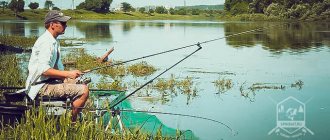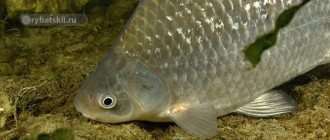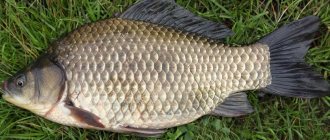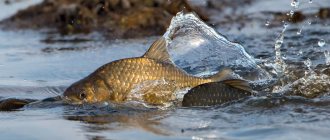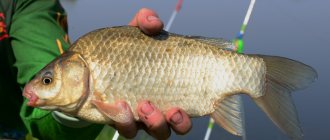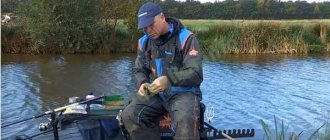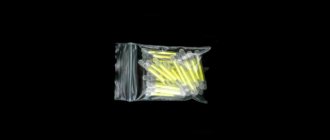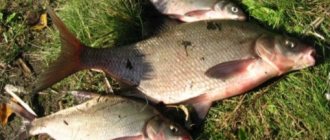Fishing for crucian carp in October
The peculiarities of catching crucian carp in October are directly related to the preparation of the fish for wintering. This determines the natural activity of the fish:
- The bite improves on quiet cloudy days, during periods of stable weather;
- A comfortable depth for fishing is 2-5 meters - at this depth the water is warmer than on the surface and in shallow places;
- In cloudy weather, the bite begins after the morning cool has retreated from 11-12 o'clock;
- In clear weather, crucian carp begins to feed from dawn until 9-10 o'clock and an hour before sunset and darkness;
- The feeding period is short-term and lasts from 3 to 5 hours a day;
- Movements around the reservoir, especially long-distance ones, are practically excluded - the fish gather in schools and feed in places of future wintering;
- The bite occurs in limited areas, and not throughout the entire reservoir;
- The purpose of bait is to attract interest and maintain the activity of the fish, and not to saturate, since the fish do not need much food during this period;
- A sign of a good bite is the prolonged Indian summer;
- A good bait option would be a mixture of barley with the bait used to catch, usually a worm, maggot or bloodworm, diluted up to 50% with soil or sand;
- Up to 70% of bait - 5-6 balls, thrown at the beginning of fishing;
- Excellent results are obtained by attaching fish when the fisherman, leaving the fishing place, throws several handfuls of bait into the water, accustoming them to the feeding place;
- The bites of crucian carp are rare, but they bite, in October there are large specimens;
- Some kind of guarantee of a bite can be casting it “under the nose” of the fish.
Read also: All about crucian carp and its fishing
The bite of crucian carp is unpredictable even on fine summer days, and even more so in the fall in October. The main factor influencing the bite is the weather. Stable weather for several days will provide an opportunity for picky fish to bite.
When to catch crucian carp at night
But when should you go night fishing for crucian carp? And here you should know that it is not caught at night all year round and there are periods when night fishing becomes stable and effective, but it happens the other way around, when such fishing is doomed to failure or, at least, not catchable at all.
It should be said right away that spring and autumn are not particularly suitable for night fishing for crucian carp. During these periods, the water is not warm enough, the air temperature is also not high enough, and at night it even drops to a very uncomfortable level. In spring and autumn, crucian carp will be active towards noon, when the temperature approaches its daily maximum, and will rest at night.
Summer is the ideal time to go after crucian carp at night. Summer nights are very comfortable for both fish and fisherman. With the onset of dusk, the heat of the day subsides, and the long-awaited evening coolness sets in. The fish's appetite awakens and it goes out in search of food.
The summer night is favorable for fishing not only because of the comfortable temperature. At this time, the crucian carp is not bothered by a predator; the crucian carp can relax and devote all this time to searching for food. He becomes more relaxed at night, becomes less cautious and timid, and his bites become more confident.
Also, night is an ideal time for large crucian carp, which may not be active at all during the day. With the onset of darkness, he goes out in search of food and the fisherman has a good chance of catching a trophy specimen.
But night fishing doesn't mean you have to come fishing at night. No, it’s better to arrive early, so that it is still light. It is ideal to arrive at the fishing spot around 18:00. Having arrived in advance, you can calmly lay out your fishing rods, mix up bait, throw in gear, prepare firewood, set up a tent or arrange a place for convenient fishing.
The night bite can start at any time. Much depends on the reservoir and weather. Sometimes crucian carp starts biting at sunset and ends in the morning. Sometimes the bite lasts for a certain time, for example from 12 to 3 am. By studying your pond, you will quickly understand the fishing hours on it and will be able to adapt to this time.
Catching crucian carp in October with a float rod
A float rod is the main tool for catching crucian carp in October. For fishing from the shore, telescopic rods with a length of 6-7 meters are used, from a boat - 3-5 meters.
In October, fishing from the shore may require long casting, so it is necessary to use a light-class spinning reel and equip the rod with guides.
Read also: Installation of a fishing rod for crucian carp from A to Z
Installation of a float rod
For fishing in October, both a rig with a sliding rig and one with a float attached to a fishing line with a carrying capacity of about 2-3 grams with a long keel that prevents collapse on the wave are used. Hooks - light No. 2.5-5 according to the Soviet classification. The fishing line is painted in a color that does not alarm the fish - green, brown, etc., depending on the fishing location. The diameter of the main line is no more than 0.15 mm, the leader - 0.08-0.12 mm.
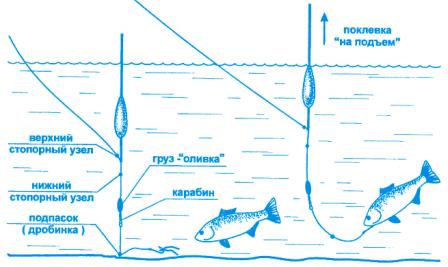
Loading the float rod
Autumn fishing assumes that the weather conditions will not be particularly comfortable - wind, waves, rain. Therefore, the load should be heavy, allowing accurate casting in windy weather and reducing the possibility of the gear being carried away by waves. The float-weight ratio should ensure maximum sensitivity - the slightest resistance to the tackle when biting can scare away the fish.
Bait for crucian carp in autumn
Feeder bait for crucian carp in the fall should not be coarse, but should be finely ground. This is necessary so that the fish cannot quickly get enough and leave the fishing spot. Bait with a large fraction should attract the “bait”, but he will quickly get enough and leave the point without reaching the hook with the bait. The food should be like dust, and then the fish will not be able to quickly satisfy its appetite.
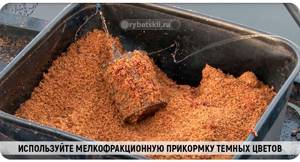
Usually, finely ground baits are used for fishing in cold water. In this case, it is recommended to pass the dry mixture through a 2 mm sieve before kneading and then proceed to kneading. When choosing purchased food, you can choose either a specialized mixture for crucian carp, or food for bream and classic food for carp. At the same time, you can safely mix different mixtures and it works well.
In the fall, when fishing with a feeder, we use only dark-colored bait, for example, black, brown, gray. This is necessary so that the food does not contrast at the bottom of the reservoir. Yellow, red, green and other bright colored baits are not suitable for autumn fishing.
Crucian carp is very sensitive to flavors, and therefore it is recommended not to add additional flavors to the bait in the second half of autumn. Smells such as strawberry, anise, tutti-frutti, scopex will only scare away the fish. The bait itself already contains the necessary aroma to attract fish, and there is no need to enhance it further.
It is recommended to mix the food strictly on the water from the reservoir where the fishing will take place. No tap water or even settled water. The crucian carp doesn't like it.
You also need to add the live component to the feed in small portions. While fishing, add 3-4 large bloodworms to the mixture, and this will be enough to attract the attention of crucian carp. You can add a little finely chopped worm.
If you want to prepare bait yourself, we offer the following proven recipe:
- 1/5 – steamed cake;
- 1/5 – steamed millet;
- 3/5 – soil.
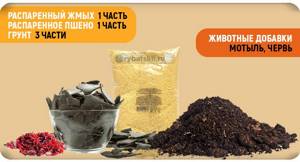
You can also add some bloodworms or worms to this food.
Fishing for crucian carp in October on a feeder
Fishing for crucian carp on a feeder in October is successful if it is impossible to get fish from the shore with float rods. Among other things, the feeder is an ideal tackle for fishing at depths, where crucian carp are located in the fall. The feeder is also great for fishing in windy weather with excellent sensitivity.
We advise you to read the report on fishing on the Don River (wintering pit, Volgograd region): catching large crucian carp on a feeder
Feeder rod and reel for catching crucian carp in October
Depending on the fishing conditions, the feeder rod is selected with a length of 3.0-3.6 meters. Test rod is about 60-80 grams.
Light or medium class spinning reel 1500-2500. The presence of a well-adjustable clutch is mandatory - a thin leash requires precise adjustment.
Fishing line, leash, hook for feeder
When choosing equipment for fishing in water that is clearer than in summer, you need to start from the principle of invisibility. Therefore, we place the main line on the feeder no thicker than 0.16-0.18 mm, and the leash thinner than 0.14 mm.
Read also: What length of leash to use
Hooks are selected according to the size of the bait from No. 4 to No. 6 according to the domestic classification. For animal baits, they are better suited with a long shank, for plant baits – with a short shank.
Crucian carp is not particularly picky about feeder equipment. All classic ones are suitable for catching it - symmetrical and asymmetrical loops, Gardner loops, paternosters, etc.
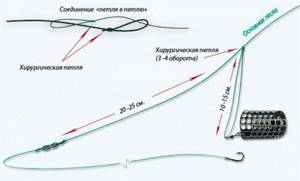
Advice! To fish on the bottom with a deep layer of silt, you need to place a foam ball on the hook.
Read also: Styrofoam for crucian carp? YES!
To successfully catch crucian carp in October, you need to fulfill only three conditions - choose the right place and tackle, and also guess the “tasty” bait for it.
Fishing methods
They use the same methods of catching crucian carp as in the summer. Usually this is a picker, a float rod, a rubber donka, a classic donka. A float rod allows you to maintain the best fishing pace, allowing you to take one or two more out of the water during the fish’s activity than bottom gear. At the same time, of all the varieties of float tackle, it is worth giving preference to a fly fishing rod. It is quite simple, lightweight, and is not afraid of water and rain, since it does not have a coil. For large crucian carp it is equipped with a rubber shock absorber, to which the main fishing line is tied.
Fly fishing rod
Another advantage of the fly rod is that with its help you can achieve an instant reaction to hooking. If the fishing rod is with a reel, the line to the hook will be twice as much as on the fly rod, or even more if cast with a reel. When hooking, it will spring twice as much, the hook will not be so good, and there will be more crucian fish coming off. It will be faster to pull the hook out of the grass by twitching with a fly rod, and crucian carp loves places where there is a lot of grass. However, it will not be possible to fish at a long distance with a fly rod, and here it is worth giving preference to match and Bolognese tackle. The optimal length for a fly fishing rod for crucian carp is from 4 to 6 meters.
Match fishing rod
Often used by lovers of float fishing when it is impossible to reach the fish at a short distance. This tackle has proven itself well when catching any species of pond fish, including crucian carp. The fishing distance with it is actually equal to the distance of the picker and is limited only by the visibility of the float. The latter is best painted yellow. They are better visible against the background of lead autumn water and gray sky than red ones. However, in autumn the weather can be different. For the yellow float, it is worth keeping a black washable marker with which you can simply repaint the antenna if suddenly at dawn the low bright sun begins to glare and dazzle your eyes.
Bolognese fishing rod
The Bolognese fishing rod is used relatively rarely when fishing for crucian carp. It does not allow you to make the same long and accurate cast as a match rod; it is approximately twice as heavy as a fly rod with the same rod length and quality. It performs well when fishing in line, where you need to release the bait along the river. It can be used more effectively where crucian carp bite in the current - usually silver carp. It’s also suitable if you simply don’t have a fly rod in your arsenal, or you’re not sure that the crucian carp will bite closer to the shore and you want to give yourself a chance for a long cast without taking additional gear with you. Many anglers only have a lapdog, thinking that this is the best fishing rod for all situations, this is not the case.
When fishing for crucian carp, a bottom fishing rod is used where there is not much aquatic vegetation. Typically, when fall arrives, a lot of the weeds die off, leaving more room for bottom fishing. More often than others, picker fishing and donk fishing with a rubber shock absorber are used.
Picker
A picker for catching crucian carp is good because it has the best casting accuracy. You can place the bait exactly in the baited place over and over again. The picker itself allows you to catch fairly large specimens thanks to the presence of a reel, does not tire the angler as much as a long float rod and can be used by convinced feeders who do not want to switch to a float when catching crucian carp.
Feeder
A regular feeder is not so good for this kind of fishing. It gives a greater casting range, but here it is not as important as accuracy. Fishing distances in ponds are usually small, but precise casting can not only bring a catch, but also save the tackle when casting into a narrow window or corridor among plants.
A bottom fishing rod with a rubber shock absorber is good because it allows you to achieve a faster fishing pace than a regular bottom fishing rod. A lot of time is saved on re-throwing the tackle. The rubber band does this for the fisherman. In terms of fishing speed, the rubber band is very close to the picker. In addition, you can put more hooks on an elastic donk than on a regular hook. A large number of hooks allows you to quickly determine what the crucian carp will bite on better, and also increases the chances of a bite. However, in the fall, crucian carp is much less picky than in the summer, but more on that later.
The main disadvantage of most bottom fishing rods is that they collect a lot of grass. When fishing with a float, you can set the depth, and the bait will be located exactly above the carpet of plants, or the leash and hook will lie on it. As a rule, in crucian carp areas there is a dense carpet of hornwort and elodea, sometimes reaching a thickness of two meters. The bottom fishing rod usually sinks the weight into this carpet, and the weight drags the bait along with it. To avoid this, anglers often use extra-long leaders, and the bait remains at the top, despite the position of the weight. This affects the registration of bites, but the fish more often finds the bait at the top if it is not lost among the plants. But where it is clean, you can and should use donka, preferably with a feeder.
Video
Catching crucian carp with a float rod video
Fishing for crucian carp in October video
Fishing with Palych. In mid-October, taking three fishing rods and worms with me, I went fishing to try to catch a good crucian carp in a familiar lake.
I arrived at about 10 o'clock, before lunch it was +5 C and sunny. Arriving at the place, I saw obvious traces of the activity of “networkers” - several visits to “nonsense”, because of this, the mood of course worsened. But there’s nothing to be done, I came fishing for autumn crucian carp, which means I have to try and try to catch it, preferably a larger one.
